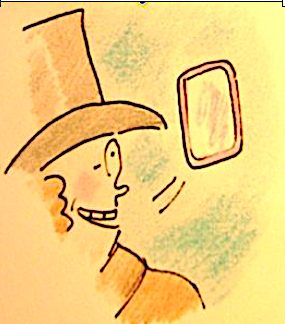Alan Dunn, Cartoonist, Fine Artist
 A social media post by The Charles Hosmer Morse Museum of Modern Art alerted me to a side of Alan Dunn I’d skirted over for years — that he was an accomplished watercolorist outside of the work he did for The New Yorker (where he contributed 9 fabulous covers between 1943 and 1963, not to mention his 1,981(!) cartoons).
A social media post by The Charles Hosmer Morse Museum of Modern Art alerted me to a side of Alan Dunn I’d skirted over for years — that he was an accomplished watercolorist outside of the work he did for The New Yorker (where he contributed 9 fabulous covers between 1943 and 1963, not to mention his 1,981(!) cartoons).
This page from Meet The Artist! (a 1943 catalog of work exhibited at the M.H. de Young Memorial Museum) informs us of Dunn’s fine art creds.
Here’s just one of three Dunn watercolors (“Garden Entrance to Laurelton Hall,” c.1925) held by the Charles Hosmer Morse Museum of Modern Art:
And here is Mr. Dunn’s very last New Yorker cover (a beauty!):
Alan Dunn’s A-Z Entry:
Alan Dunn Born in Belmar, New Jersey, August 11, 1900, died in New York City, 1975. NYer work: 1926 – 1974 Key collections: Rejections (Knopf, 1931), Who’s Paying For This Cab? (Simon & Schuster, 1945), A Portfolio of Social Cartoons ( Simon & Schuster, 1968). One of the most published New Yorker cartoonists (1,906 cartoons) , Mr. Dunn was married to Mary Petty — together they lived and worked at 12 East 88th Street, where, according to the NYTs, Alan worked “seated in a small chair at a card table, drawing in charcoal and grease pencil.”
_____________________________________________________________________
Tilley Watch Online, The Week Of May 26-30, 2025
 An end of the week listing of New Yorker artists whose work has appeared on newyorker.com features
An end of the week listing of New Yorker artists whose work has appeared on newyorker.com features
Daily Cartoon: Michael Lukk Litwak, Adam Douglas Thompson, Christopher Weyant, J.A.K., Asher Perlman, P.C. Vey. See them here.
Barry Blitt’s Kvetchbook: “Oval Office Ambush”






What beautiful technique! Laurelton Hall was Louis Comfort Tiffany’s estate on Long Island. Much of it burned in 1957. The columns, or similar ones, today are restored and on view in the Metropolitan Museum of Art’s New American Wing. I’ll go out on a limb and suggest that it’s possible Dunn’s watercolor could have been a New Yorker cover submission, particularly if it was done later than 1925 when four-color printing was adopted for the covers. That wall at the extreme left might then have served as the magazine’s strap.